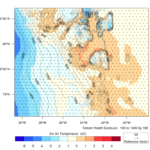HPC usage report from J. Turton, T. Mölg and E. Collier
High-resolution (1 km) Polar WRF output for 79°N Glacier and the northeast of Greenland from 2014 to 2018
The northeast of Greenland is of growing interest due to changes taken place on the large marine-terminating glaciers which drain the northeast Greenland ice stream (NEGIS). Here we present the output of high-resolution Polar WRF model runs from 2014 to 2018 at hourly resolution over the NEGIS region. This dataset will be valuable for further atmospheric, surface mass balance and oceanic studies, for the investigation of present conditions of the glacier area.
Motivation and problem definition
Despite the importance of this region, relatively few atmospheric studies have investigated the current conditions. Previous modelling studies use relatively coarse horizontal (25 km) and temporal (daily) resolution. But in order to investigate the important atmospheric processes and their impacts on the glacier surface, higher resolution simulations are required.
Methods and codes

We used the polar modified version of the Weather Research and Forecasting (WRF) model, version 3.9.1.1, configured with three domains of horizontal resolution 25 km, 5 km and 1 km. The innermost domain is centered over northeast Greenland. To initiate the model and fore the boundaries, ERA-Interim data is used between 1st August 2013 to 31st December 2018. WRF is developed and maintained by the National Centre for Atmospheric Research (NCAR), and the Polar adaptations are developed by Byrd Polar Research Institute in Ohio. The simulation period was split into four annual simulations, each of which required 10 days of wall time, with 16 nodes on the Meggie computer cluster.
Results
We compared the model output with in-situ observations from two automatic weather stations. The simulations represent the near-surface meteorological conditions fairly well, with small mean biases in air temperature, wind speed and radiation components. The largest biases were found in summer with a positive specific humidity bias and positive wind direction bias. Further analysis should be conducted by users of the dataset.
Outreach
The dataset is published in the following publication: Turton, J.V., Mölg, T. and Collier, E: High-resolution (1 km) Polar WRF output for 79°N Glacier and the northeast of Greenland from 2014 to 2018, Earth Syst. Sci. Data, 12, 2, 1191-1202. 2020: https://doi.org/10.5194/essd-12-1191-2020.
Output from the simulations were shown at ‘Die lange Nacht der Wissenschaft’ in November 2019, Erlangen.
Daily averaged data from the innermost domain are available for download from a public repository at the Open Science Framework (Turton, 2019: https://doi.org/10.17605/OSF.IO/53E6Z)
Researcher’s Bio and Affiliation
Dr. Jenny Turton is a postdoctoral researcher in the Climate System Research Group, Institute of geography at the Friedrich-Alexander University. Her research focuses on polar meteorology and the interactions between atmosphere and glacier surfaces in the Arctic and Antarctic.
